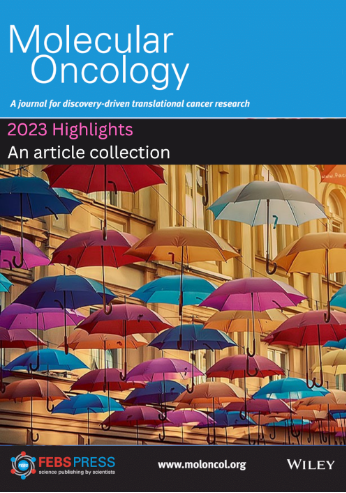RNA polymerase I inhibition induces terminal differentiation, growth arrest, and vulnerability to senolytics in colorectal cancer cells
IF 5
2区 医学
Q1 ONCOLOGY
引用次数: 0
Abstract
Ribosomal biogenesis and protein synthesis are deregulated in most cancers, suggesting that interfering with translation machinery may hold significant therapeutic potential. Here, we show that loss of the tumor suppressor adenomatous polyposis coli (APC), which constitutes the initiating event in the adenoma carcinoma sequence for colorectal cancer (CRC), induces the expression of RNA polymerase I (RNAPOL1) transcription machinery, and subsequently upregulates ribosomal DNA (rDNA) transcription. Targeting RNAPOL1 with a specific inhibitor, CX5461, disrupts nucleolar integrity, and induces a disbalance of ribosomal proteins. Surprisingly, CX5461‐induced growth arrest is irreversible and exhibits features of senescence and terminal differentiation. Mechanistically, CX5461 promotes differentiation in an MYC‐interacting zinc‐finger protein 1 (MIZ1)‐ and retinoblastoma protein (Rb)‐dependent manner. In addition, the inhibition of RNAPOL1 renders CRC cells vulnerable towards senolytic agents. We validated this therapeutic effect of CX5461 in murine‐ and patient‐derived organoids, and in a xenograft mouse model. These results show that targeting ribosomal biogenesis together with targeting the consecutive, senescent phenotype using approved drugs is a new therapeutic approach, which can rapidly be transferred from bench to bedside.RNA聚合酶I抑制诱导结直肠癌癌症细胞的末端分化、生长停滞和对解毒剂的易感性
在大多数癌症中,核糖体的生物发生和蛋白质合成是不受控制的,这表明干扰翻译机制可能具有重要的治疗潜力。在这里,我们发现肿瘤抑制因子腺瘤性息肉大肠杆菌(APC)的缺失,它构成了结直肠癌(CRC)腺瘤癌序列的启动事件,诱导RNA聚合酶I (RNAPOL1)转录机制的表达,随后上调核糖体DNA (rDNA)转录。用特异性抑制剂CX5461靶向RNAPOL1,破坏核核完整性,诱导核糖体蛋白失衡。令人惊讶的是,CX5461诱导的生长停滞是不可逆的,并表现出衰老和终末分化的特征。从机制上讲,CX5461促进MYC相互作用的锌指蛋白1 (MIZ1)和视网膜母细胞瘤蛋白(Rb)依赖性的分化。此外,RNAPOL1的抑制使结直肠癌细胞容易受到抗衰老药物的影响。我们在小鼠和患者来源的类器官以及异种移植小鼠模型中验证了CX5461的治疗效果。这些结果表明,靶向核糖体生物发生并使用已批准的药物靶向连续衰老表型是一种新的治疗方法,可以迅速从实验室转移到临床。
本文章由计算机程序翻译,如有差异,请以英文原文为准。
求助全文
约1分钟内获得全文
求助全文
来源期刊

Molecular Oncology
医学-肿瘤学
CiteScore
12.60
自引率
1.50%
发文量
203
审稿时长
6-12 weeks
期刊介绍:
Molecular Oncology highlights new discoveries, approaches, and technical developments, in basic, clinical and discovery-driven translational cancer research. It publishes research articles, reviews (by invitation only), and timely science policy articles.
The journal is now fully Open Access with all articles published over the past 10 years freely available.
 求助内容:
求助内容: 应助结果提醒方式:
应助结果提醒方式:


